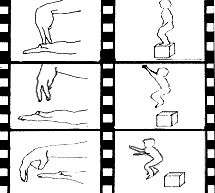Sign and Spoken Language TM Program
The development of the training films which compose this program stems from the Millers' research finding* that non-verbal children, previously unable to understand spoken language or communicate, could begin to do so after signs, spoken words and their related objects or events were simultaneously presented them.
Following such presentations, children could, for the first time, begin to respond to spoken words without requiring sign or object accompaniment. With further training, they could indicate their needs through signs and spoken words.
All four training films use manual signs adapted from the American Sign Language (ASL) for the deaf and relate these signs to their objects and to the spoken word. The dramatic impact of the films is enhanced by careful editing which blends signs with their referents...

For example, the hand sign for jump (two fingers of the right hand jump off the left palm) blends readily with the image and thus the meaning of a child jumping off a stool, just as the hand sign for break (two hands simulate breaking something) readily blends on film with two hands breaking a stick. Similarly, manual signs for eat, drink, fork, knife, spoon, pour, plate , and many others are juxtaposed on film with their object in such a way that the sign and its meaning become intimately related. At the same time, the inclusion of the appropriate spoken words on the sound track makes possible a transfer of meaning from sign to spoken word.
Each training film is organized around a particular cluster of concepts and seeks to establish certain linguistic functions. The goals for each training film are given below.
Training Video Segment One:
Signs, Sounds and their Referents (Actions)
Goal:
- To contribute to the survival of nonverbal children by providing them with receptive understanding of 18 actions meanings in sign and spoken form;
- To establish expressive ability to use these signs and spoken words in an appropriate and intentional manner. in a variety of situations.
The 18 action meanings taught include:
come, go, stop, up, down, get-up, sit-down, open, close, pickup, drop, walk, run, jump, fall, push, pull, break.
Eighteen (18) concepts, approximately 11 minutes.
Training Video Segment Two:
Food Situations
Goal:
- To provide exceptional children with signs and word meanings that will allow them to function more appropriately in food and food-related situations.
The 17 food-related concepts taught in this series include:
knife, fork, spoon, plate, glass, table, chair, eat, pour, drink, bread, salt, ketchup, roll, cookie, egg, pie.
Seventeen (17) concepts, approximately 11 minutes.
Training Video Segment Three:
Familiar Objects and Events
Goal:
- To extend the understanding of nonverbal children to include familiar objects and events in their immediate surrounds.
The 15 familiar concepts include:
comb, toothbrush, sleep, wash, awake, hot, sweep, house, cat, tree, car, boat, ball, man, boy.
Fifteen (15) concepts approximately 6 minutes.
Training Video Segment Four:
Two-Sign/Two-Word Combinations
Goal:
- To help children achieve basic syntactical constructions involving two sign/two word combinations. Syntactical constructions used include: verb + noun (eat apple, pick-up table, drop egg) noun + verb (chair falls, hammer breaks) adjective + noun (big/little fork, big/little chair) noun + adverb (table up/down) adverb + noun (more cookie) possessive pronoun + noun (my chair) noun + preposition (cat in/out).
Whenever possible, dramatic situations relate directly to the grammatical constructions being taught.
For example, one sequence shows a cat going in a paper bag on a table (cat in) then coming out of the bag (cat out). Following this, the cat jumps off the table (cat jumps), approaches food and begins to eat (cat eats). Seven (7) syntactical constructions, approximately 15 minutes.
The Sign and Spoken Language program kit includes a bound Teacher's Manual.
Available in VHS or 3/4" U-Matic videocassette formats.
|

